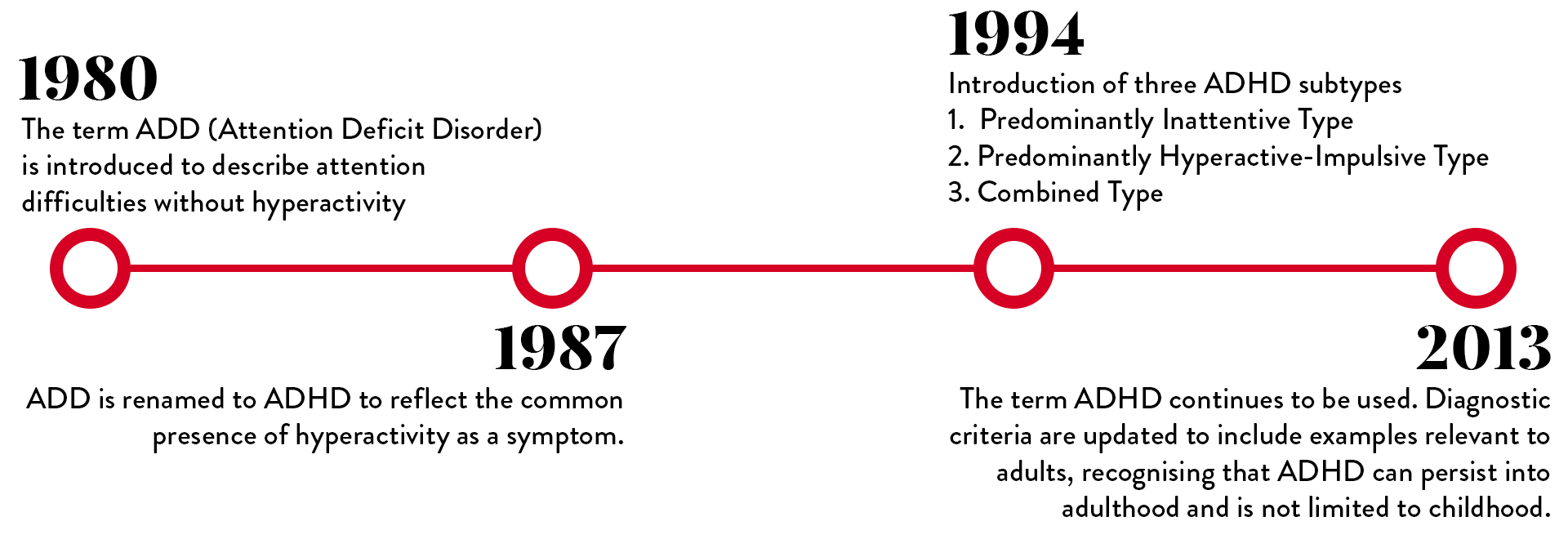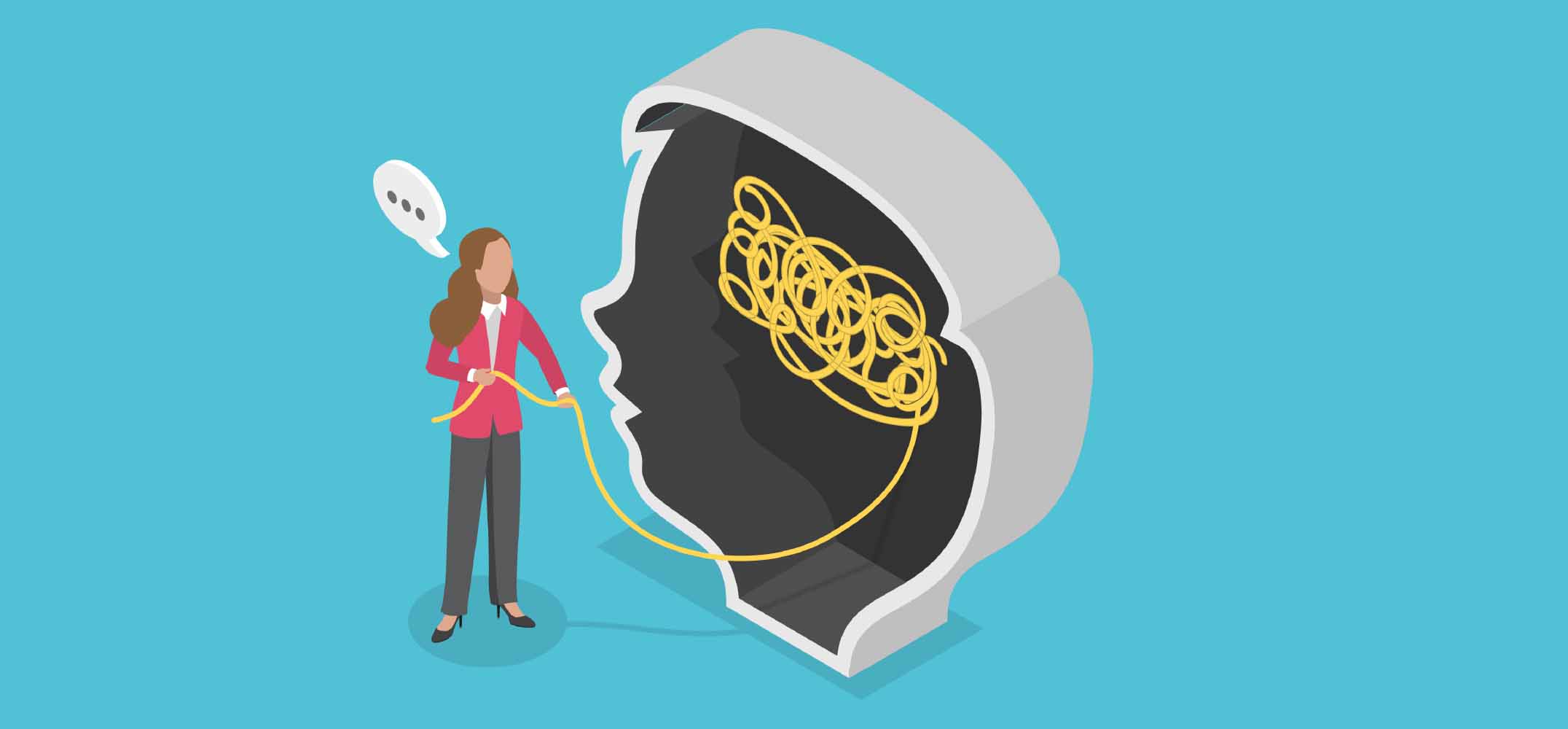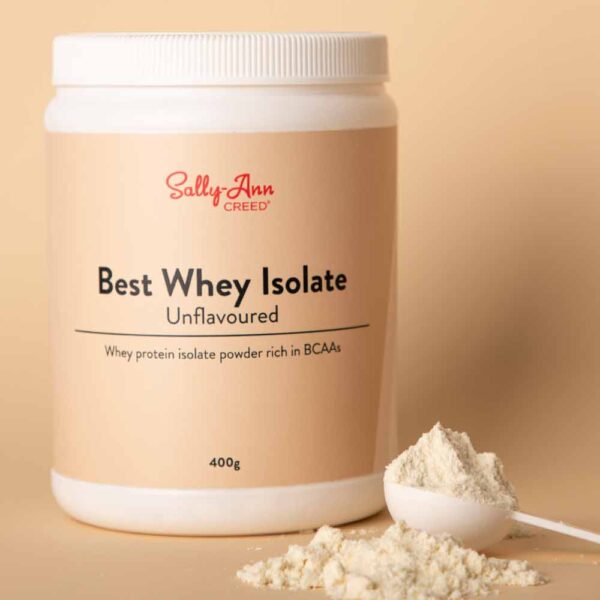Attention-Deficit/Hyperactivity Disorder (ADHD) is a neurodevelopmental condition that affects both children and adults. It is characterised by a persistent pattern of inattention, hyperactivity and/or impulsivity that interferes with daily life. ADHD is not a behavioural problem or a parenting issue, it’s a brain-based condition with biological differences in brain function, size and activity.
The understanding and naming of ADHD have evolved over time. Here’s a quick look at how our definition of ADHD has changed:

And this is very important—although ADHD is still labelled a “disorder” in medical circles, at Sally-Ann Creed we prefer to think of it as a different brain wiring, not something broken, but something unique. Science backs this up, brain scans show clear differences in structure, size and function in those of us with ADHD compared to neurotypical brains. But ultimately, remember these aren’t flaws- they’re variations. Like a different operating system.
The science?
- Frontal Lobe
This area is responsible for decision-making, planning, emotional regulation and impulse control. In ADHD, these functions may be less consistent or harder to access, which can affect organisation and self-management. - Prefrontal Cortex
This plays a role in organising thoughts, focusing attention, managing emotions and understanding social cues. In ADHD, it may be slightly smaller or show reduced activity, contributing to difficulties with focus and emotional regulation. - Basal Ganglia
This region helps with motivation, habit formation and translating intention into action. In ADHD, it may function less efficiently, which can explain why individuals often struggle to initiate or follow through on tasks even when they know what needs to be done. - Anterior Cingulate Cortex (ACC)
Is involved in shifting attention, managing multiple tasks and learning from feedback. Reduced activity in this area can make it harder to adapt to change, manage competing demands or shift focus effectively. - Cerebellum
Though traditionally associated with coordination and movement, the cerebellum also supports attention, timing and certain cognitive functions. In ADHD, it may be smaller in size, potentially contributing to issues with focus, timing or working memory.
Symptoms of ADHD can look different for everyone.
According to the American Psychiatric Association’s Diagnostic and Statistical Manual, Fifth edition (DSM-5), there are nine signs linked to the inattention side of ADHD. To be diagnosed with ADHD, a person needs to show a certain number of these signs, depending on their age:
Children 16 years and younger: Must show six or more symptoms of inattention and/or hyperactivity-impulsivity.
Teens 17 and older, and adults: Must show five or more symptoms.
A healthcare professional must make the diagnosis. This information is just to help you understand the criteria better.
Neurotransmitters and ADHD
Neurotransmitters are chemical messengers that help different parts of the brain and body communicate with each other. They play a vital role in regulating mood, focus, sleep, emotions and even how we react to stress. Some well-known neurotransmitters include serotonin (linked to mood and wellbeing), melatonin (involved in sleep), GABA (which helps calm the nervous system) and dopamine, which plays a key role in ADHD.
Dopamine is especially important when it comes to attention and motivation. It’s often called the “feel-good” chemical because it’s involved in the brain’s reward system, helping us feel pleasure when we do something enjoyable. But it does much more than that. Dopamine also helps with motivation, drive, focus, attention, learning and memory and in people with ADHD, dopamine doesn’t always work as it should. Either there isn’t enough of it in certain parts of the brain, or it’s not being used effectively. This can make it harder to focus, stay motivated, or regulate emotions, all core challenges in ADHD.
This is important to understand because it helps explain why certain nutrients and foods are recommended for ADHD. Many of the brain chemicals involved in attention, mood and focus ( like dopamine ) are made from nutrients we get through food. If the body doesn’t have enough of the right building blocks, these brain messengers can’t be produced or function properly.
For example:
- Protein rich foods (like eggs, fish, chicken, nuts, seeds and legumes) provide amino acids which are needed to make neurotransmitters like dopamine.
- Omega-3 fatty acids (found in oily fish like salmon, flaxseeds and walnuts or our lovely Sally-Ann Creed Omegas) help brain cells communicate better and support attention and behaviour regulation.
- Iron, zinc, magnesium and vitamin B6 are also crucial for dopamine production and balance and low levels of these nutrients have been linked to ADHD symptoms.
So, nutrition isn’t a cure for ADHD, but it can be a powerful support.
Just like every system and organ in your body, your brain needs nutrients to work properly. Without them, you may experience issues like brain fog, mood swings, poor memory or difficulty concentrating- and that’s whether you have ADHD or not. For those with ADHD, not getting the right nutrients can make symptoms even more challenging.
According to literature, there is still no specific “ADHD diet,” the best approach is to follow a healthy, balanced eating pattern. This means loading up on fruit, vegetables, whole grains when needed, healthy protein and healthy fats to nourish your brain and body. While research is still ongoing, some studies have shown that certain nutrients can support brain function and help ease symptoms of ADHD. On the flip side, missing key nutrients could make it harder to manage those symptoms.
What we do know is that a healthy, diverse and balanced diet is associated with decreased ADHD symptoms. A systematic review supports this, indicating that healthy dietary patterns are linked to a decreased risk of ADHD, while unhealthy diets may increase this risk. Notably, adherence to the Mediterranean diet, which emphasises fruits, vegetables, whole grains when needed, legumes, fish and healthy fats like olive oil has been associated with a lower risk of ADHD symptoms. What else does science tell us?
The main dietary recommendations that have been studied look at:
🧠 Reducing and avoiding sugar, especially sugar sweetened beverages
- We’ve all heard the age-old story- our children head off to a birthday party (or a visit to Granny’s house) and return home bouncing off the walls, thanks to a whirlwind of sugary treats and sweets. While sugar is often blamed for hyperactivity, research tells a bit more nuanced story. A large meta-analysis in the 1990s found no consistent link between sugar and changes in children’s behaviour or thinking skills. An interesting 2020 study showed that dietary sugar alone did not have a significant effect on ADHD symptoms, however sugar sweetened beverages were associated with 40% and higher risk of ADHD symptoms!
- One theory is that sugar causes a surge of dopamine (the brain’s feel-good chemical), particularly in areas of the brain involved in reward and attention. Over time, this could blunt dopamine sensitivity, which overlaps with what we see in ADHD. Plus, rapid sugar spikes can lead to blood sugar crashes and adrenaline surges, another possible route to hyperactivity.
- We don’t need to fear sugar as overly restrictive diets can make kids feel controlled, anxious around food or even see eating as a form of punishment. But we do want to be mindful of how much of it, and in what form, it’s entering our children’s diets or adult ADHD-er. Occasional treats are part of childhood, life and celebration, and they absolutely have their place. What matters more is the pattern of eating.
- Instead of focusing on removing sugar entirely, the aim is to reduce excess intake of added sugars, especially from sources like sugary drinks, sweetened cereals and processed snacks and to create a foundation of real, nourishing foods most of the time. It’s about balance, not banning.
Teaching kids to enjoy a variety of whole foods, while also learning that sweets can be part of life in moderation, helps develop a healthy, sustainable relationship with food.
🧠 In certain cases doing an elimination diet
- In certain cases, elimination diets are explored to see if specific foods may be contributing to ADHD-related behaviours. The idea is simple: if behaviour noticeably improves during the elimination phase, and symptoms return when certain foods are reintroduced, those foods may be acting as triggers.
- This approach typically involves a strict, short-term elimination phase (around 2–5 weeks), where only a limited number of low-reactive foods are allowed. If there’s a significant improvement in behaviour, foods are reintroduced one at a time over many months to identify potential triggers.
- However, it’s important to approach this carefully and under professional guidance.
- Some research has found that some children may benefit from this approach in the short term, showing reduced ADHD symptoms and even fewer emotional outbursts or oppositional behaviours. However, it’s worth noting that some of these improvements may be due to parental expectations, more structured mealtimes, or the extra attention children receive during the process, not necessarily the foods themselves.
- That’s why elimination diets should always be done under professional guidance, ideally with a dietitian and a healthcare provider. Without this support, there’s a risk of cutting out too many foods, which can lead to nutritional deficiencies, increased mealtime stress and a poor relationship with food.Unless a child/adult ADHD-er has a confirmed allergy or intolerance, there’s rarely a need to strictly avoid specific foods.
🧠 Artificial food colours and additives
- Parents often notice that their child’s ADHD symptoms, especially hyperactivity, seem to get worse after eating foods with artificial colours.
- Dr Feingold, an American paediatrician and allergist, was one of the first to suggest in the 1970s that some children might be sensitive or allergic to these food colorings and synthetic flavours.
- Systematic reviews have found it challenging to give firm conclusions as some have shown a small significant adverse effect on ADHD in some children and in others showed a nonsignificant effect.
🧠 Micronutrient (vitamin and mineral) supplementation
- There is some evidence that ADHD may be associated with some nutrient deficiency risks.
- Magnesium: Children with ADHD have lower levels of magnesium than those who do not, magnesium deficiency can lead to symptoms such as reduced concentration, fatigue, mood swings (aggression) and anxiety. Magnesium may also help with symptoms of insomnia (battling with sleep) and anxiety, both of which are common in ADHD.
- Iron: Iron plays an essential part in production of dopamine and other neurotransmitters that play an important role in brain function and behaviour. Low iron levels may impact these brain chemicals and contribute to ADHD symptoms.
- Zinc: Some studies suggest that zinc might have a beneficial role in improving symptoms in some children with ADHD. Zinc is an important mineral that helps regulate chemical messengers in your brain.
- Vitamin D: Vitamin D plays a key role in brain development and function and some research suggests that low levels of vitamin D might be linked to an increased risk or severity of ADHD symptoms.
🧠 Omega 3 essential fatty acid supplementation
- An incredibly important factor to consider. Omega 3 has been reported to be lower in children with ADHD and this is vital because it has a huge role in brain function and structure. In fact the brain itself is made up of 70% of DHA (a type of omega 3).
- Some trials have shown that there is some improvement in symptoms and performance when supplementing with omega 3. If one is unable to get in 2-3 servings of fatty fish, it may be beneficial to include a good omega 3 supplement to get in brain healthy DHA and EPA.
Behaviour tips and tricks
ADHD affects and impacts nutrition by: forgetting to eat, having low energy or motivation to cook and prepare healthy meals, binge eating or eating for stimulation, decision overload or even suppressed appetite from medication.
Some little behavioural tips are:
- Create a structured eating routine- set reminders for meal times, try to eat every 3-4 hours to prevent energy crashes or impulsive eating. When motivation is low, it will help to have meal plans to set up.
- Keep snacks accessible and meals easy- batch cook when energy is high and freeze meals for later, prepare grab-and-go options like boiled eggs, trail mix, yoghurt pots.
- Reduce decision making- plan meals ahead of time (create a weekly menu) or even rotate 3 to 5 go-to meals to minimise daily decisions.
- Work with your medication schedule- if appetite is suppressed during the day, ensure breakfast is nutrient-dense and have snacks readily available for when you or your child feels hungry again.
- Add protein and healthy fats to each meal- this is to help with energy, focus and blood sugar regulation.
Parents and fellow ADHD-ers, please know that ADHD does not limit you or your future, if you are needing a reminder some ADHD individuals have gone on to be:
- The most decorated Olympian in history was diagnosed with ADHD at age 9. He credits swimming with giving him structure and focus (Michael Phelps)
- Founder of the Virgin Group, openly discusses having ADHD and dyslexia (Richard Branson)
- Actor and producer, has shared that he was diagnosed with ADHD (and dyslexia) as a child (Channing Tatum)
- Had incredible imaginations and produced incredible productions (Walt Disney)
- Become innovators and able to view from a whole new perspective (Albert Einstein)







